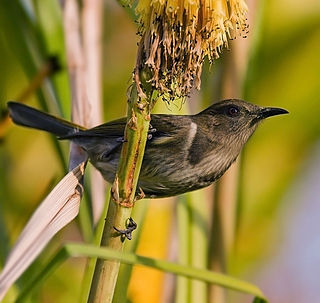
The honeyeaters are a large and diverse family, Meliphagidae, of small to medium-sized birds. The family includes the Australian chats, myzomelas, friarbirds, wattlebirds, miners and melidectes. They are most common in Australia and New Guinea, and found also in New Zealand, the Pacific islands as far east as Samoa and Tonga, and the islands to the north and west of New Guinea known as Wallacea. Bali, on the other side of the Wallace Line, has a single species.

Buttonquail or hemipodes are members of a small family of birds, Turnicidae, which resemble, but are not closely related to, the quails of Phasianidae. They inhabit warm grasslands in Asia, Africa, Europe, and Australia. There are 18 species in two genera, with most species placed in the genus Turnix and a single species in the genus Ortyxelos.
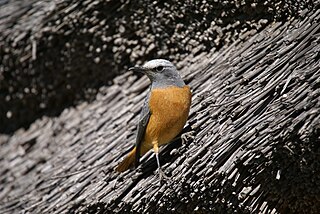
The rock thrushes, Monticola, are a genus of chats, medium-sized mostly insectivorous or omnivorous songbirds. All are Old World birds, and most are associated with mountainous regions.

Psophodidae is a family of passerine birds native to Australia and nearby areas. It has a complicated taxonomic history and different authors vary in which birds they include in the family. In the strictest sense, it includes only the five or six species of whipbirds and wedgebills, but some authors also include the quail-thrushes (Cinclosoma), eight species of ground-dwelling birds found in Australia and New Guinea, and the jewel-babblers (Ptilorrhoa), three or four species found in rainforest in New Guinea. Others place them in their own family, the Cinclosomatidae. The Malaysian rail-babbler was formerly sometimes placed in this family, which would then be called Eupetidae.

The rail-babbler or Malaysian rail-babbler is a strange, rail-like, brown and pied ground-living bird. It is the only species in the genus Eupetes and family Eupetidae. It lives on the floor of primary forests in the Malay Peninsula and Sumatra, as well as Borneo. It is distantly related to African crow-like birds. Its population has greatly decreased because much of the lowland primary forest has been cut, and secondary forests usually have too dense a bottom vegetation or do not offer enough shade to be favourable for the species. However, it is locally still common in logged forest or on hill-forest on slopes, and probably not in immediate danger of extinction. The species is poorly known and rarely seen, in no small part due to its shyness.

The brown quail, also known as the swamp quail, silver quail and Tasmanian quail, is an Australasian true quail of the family Phasianidae. It is a small, ground-dwelling bird and is native to mainland Australia, Tasmania and Papua New Guinea and has been introduced to New Zealand and Fiji. Widespread and common throughout its large range, the brown quail is evaluated as being of "least concern" by the International Union for Conservation of Nature on the IUCN Red List of Threatened Species.

Whipbirds and wedgebills are collectively recognised in the genus Psophodes. Wedgebills are divided into the chirruping wedgebill and the chiming wedgebill. Whipbirds are divided into the eastern whipbird and the western whipbird. Subspecies of the western whipbird residing in Western Australia are known to be endangered. Psophodes is a genus of five species of songbirds endemic to Australia, known as whipbirds and wedgebills.

The painted quail-thrush is a species of bird in the family Cinclosomatidae. It is found in New Guinea. Its natural habitat is subtropical or tropical moist lowland forest.

The chestnut-breasted quail-thrush is a small endemic Australian bird which is predominantly found within the semi-arid deserts of New South Wales and Queensland.

The chestnut quail-thrush is a native Australian bird of the family Cinclosomatidae. These scrub birds are endemic to Australia and found in all states - barring Tasmania. They are relatively uncommon and are isolated to the semi-arid and arid fringes of the Australian interior.
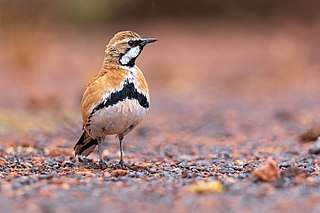
The cinnamon quail-thrush is a small to medium-sized species of bird that is endemic to Australia. This bird is found in the arid and semi-arid regions of central Australia.

The spotted quail-thrush is a species of bird in the family Cinclosomatidae. It is endemic to Australia.
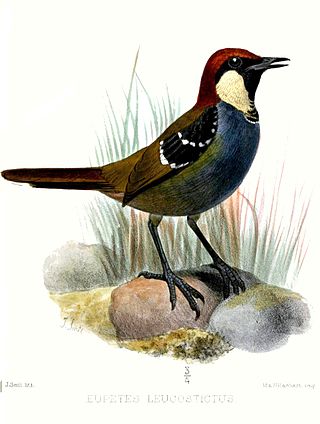
The jewel-babblers are the bird genus Ptilorrhoa in the family Cinclosomatidae. The genus contains four species that are endemic to New Guinea. The genus was once considered to contain the rail-babbler, but that species is now considered to belong to its own family. The genus is closely related to the better known quail-thrushes (Cinclosoma) of New Guinea and Australia. Together with a number of other genera they comprise the family Cinclosomatidae, although the validity of this family as a whole has been questioned.

Western quail-thrush is a species of bird in the family Cinclosomatidae. It is found in arid inland habitat in south-central Western Australia. It typically resides in dry woodland shrub with low understory on a stony ground. The climatic zones it is most commonly found in are semi-arid or arid.

The Nullarbor quail-thrush is a species of bird in the family Cinclosomatidae. It is the only Australian bird endemic to the Nullarbor Plain in southern Australia.

The Naretha bluebonnet or Naretha parrot is a bird found in a remote and arid region of Australia. It is one of two species in the genus Northiella, and was first recorded in 1921 in Central Australia.

The copperback quail-thrush is a species of bird in the family Cinclosomatidae. It was split from the chestnut quail-thrush in 2015. It is endemic to Australia. Its natural habitat is Mediterranean-type shrubby vegetation.
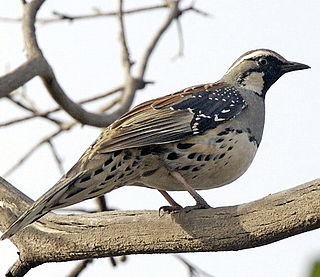
Cinclosomatidae is a family of passerine birds native to Australia and New Guinea. It has a complicated taxonomic history and different authors vary in which birds they include in the family. It includes the quail-thrushes and jewel-babblers.































